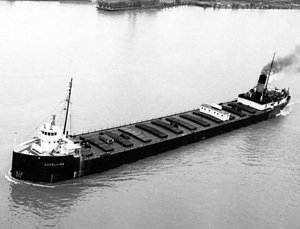The Pittsburgh and Kinsman Years
 E.C. Collins in Kinsman colors, from the Tom Manse collection and Paul C. LaMarre Jr. collection.
E.C. Collins in Kinsman colors, from the Tom Manse collection and Paul C. LaMarre Jr. collection.As the 20th Century entered its second decade, the Hawgood companies found themselves mired in legal trouble, which stemmed from some questionable financial dealings with the American Shipbuilding Company, and resulted in a number of their newest and largest vessels being sold off or reposessed under court order. The various Hawgood fleets were consolidated into the Acme Transit Company in 1911, but their fortunes never fully recovered, being further set back by the loss of the Henry B. Smith in the 1913 storm. Acme Transit finally ceased operations early in 1916, and their remaining six ships were sold to the Pittsburgh Steamship Company. Among them was the Edwin F. Holmes, which was renamed E. C. Collins by her new owners.
Over the winter of 1916-1917, the Collins underwent her first major rebuild. Her spar deck and holds were reconfigured with arch and hopper-side construction replacing the original deck support stanchions, and her wooden hatch covers were replaced with telescoping steel ones. The use of transverse steel arches to support the deck greatly strengthened the hull structure, and eliminating the stanchions in the cargo hold made these vessels easier (and therefore cheaper) to load and unload, giving them significant economic advantage over the earlier-style construction. Another change in 1916 was an increase in crew size. Before then, vessel crews worked a two-watch rotation of six hours on duty and six hours off (twice a day), but new regulations that year mandated the addition of a third watch, with each watch working four hours on/eight hours off. To accommodate the additional crew members, the deckhands' quarters on the Collins were moved to a new “doghouse” cabin, added during the 1916-17 rebuild between the #9 and #10 hatches on her spar deck. Her open wheelhouse was also enclosed at this time. Later rebuilds saw the square-framed windows in her cabins replaced with more weather-resistant portholes, and new boilers (coal-burning Scotch type, like the originals) were installed in 1927.
A division of the U.S. Steel Corporation, the Pittsburgh Steamship fleet was the largest on the Great Lakes, with well over 100 vessels when the E.C. Collins joined the company. The Collins served the giant steelmaker through the end of World War I, the Roaring 20's, the Depression years of the 1930s, and into World War II. Then, on June 15, 1943, one of her Pittsburgh fleetmates, the D.M. Clemson collided with the 605-foot steamer George M. Humphrey in the Straits of Mackinac. The Humphrey, flagship of the Steinbrenner family’s Kinsman fleet, went to the bottom in 80 feet of water and was declared a total loss. Kinsman sought to replace their lost flagship, but with the war effort still in full swing, shipyard capacity and secondhand 600-footers were in short supply. Instead, they struck a deal with Pittsburgh and purchased two of the smallest and oldest vessels in their fleet: the E.C. Collins and her identical sistership the MacGilvary Shiras (formerly the Hawgood steamer Umbria), whose combined capacity was roughly equal to that of the George M. Humphrey. That wasn't the end of the story for the sunken Humphrey, however. After over a year underwater, the wreck was subsequently raised by Captain John Roen in one of the most ambitious salvage efforts in Great Lakes history, and towed to Sturgeon Bay for rebuilding. She would go on to sail for another 44 years, finally ending her days as the Consumers Power in 1988.
After joining the Kinsman fleet in 1944, the E.C. Collins and MacGilvary Shiras continued to sail under the same names. Although they were structurally little changed from their U.S. Steel days, they were primarily engaged in the grain trade under Kinsman ownership, bringing the harvest of America’s breadbasket to the mills of Buffalo. The Collins served in this capacity until 1956, by which time new boats were being built over 700 feet long. The 440-foot, 52-year-old Collins was quickly becoming obsolete, and her days appeared to be numbered. However, instead of being sold for scrap, she was sold instead to the Huron Portland Cement Company, who saw her small size as perfect for a new role as a cement carrier.
The MacGilvary Shiras, whose history up until that point had paralleled that of the Collins, was less fortunate. Her career ended in spectacular fashion on January 21, 1959, when heavy ice floes tore her from her winter layup berth on the Buffalo River and slammed her into the steamer Micheal K. Tewksbury, which also broke free from her moorings. The two ships were carried down the river by the current until they struck the Michigan Avenue lift bridge, collapsing it. Damaged beyond repair, the Shiras was scrapped later that year, just as the Collins was embarking on her new career as the J.B. Ford.
